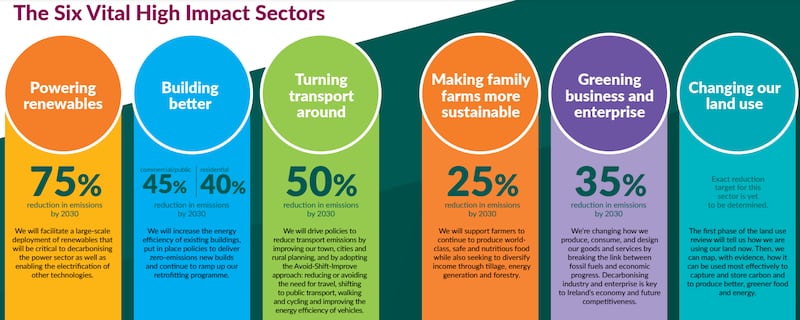The Government’s latest climate action plan is a different beast to its previous version. There is far greater detail on “the how” in cutting carbon emissions — setting out the concrete measures and roadmaps required. This includes pursuing adaptation to make the country resilient to inevitable impacts from a warming world.
It demands scaled-up actions across every sector; the painful reality of sectoral ceilings, which required such careful manoeuvring to get through the Oireachtas, is set out with clarity.
To regard this simply as the cost implications of what was adopted last summer would be a gross underestimate of their significance in trying to help get the economy and society on a path to sustainability.
There are two critical differences with the old plan, which included almost 500 actions to support the objective of a 51 per cent reduction in emissions by 2030 and carbon neutrality by 2050.
How a hotter world is affecting Ireland in five graphics
Chris Packham: ‘I was a very angry young man, confused because of my undiagnosed autism. It had an enormous impact on my life’
LA fires lay bare the spectre of an uninsurable future
Aoibhinn Ní Shúilleabháin: ‘I mourned friendships for too long that were actually past their time’
The 2023 version comes with a strong legal mandate as the first statutory plan under the Climate Act. All relevant State bodies must act based on it. This has direct consequences for every Government Minister and their department. They can be forced through legal action to get their decarbonisation efforts into line.
The second is the overarching requirement from the EU for Ireland’s separate national climate and energy plan to be revised and submitted to Brussels to include a higher degree of specificity on our path of decarbonisation and scale-up of renewables. This where the rubber of the landmark European green deal hits the road.

Cop27: What was agreed and what difference will it make?
Already there are grave doubts that Ireland will deliver its necessary contribution. It has a legally binding carbon budget mechanism for the decade — that’s the imposer of discipline and indicator of performance. But odds are against us; we are already two years into the 2021-2025 budget and emissions continue to rise, when they need to be coming down rapidly.
In that context, the most pressing problems are obvious and concentrated in transport, agriculture and the built environment.

Agriculture
Farming may be our highest emissions source but its path to decarbonisation is becoming clearer. The sector is set for unprecedented diversification into renewable energy, forestry, expanded biomass crops, shifting from dairying to tillage, increased organics and biomethane production using anaerobic digesters. Allied with this will be a much-changed fertiliser regime and improved breeding of lower-emission animals.
With it will come new income streams and an inevitable — and ultimately managed — reduction in livestock numbers, though curbing biogenic methane, the most menacing greenhouse gas, will continue to be immensely challenging.
The plan acknowledges any increase in methane emissions from continually increasing livestock numbers will put the achievement of an overall 25 per cent reduction in emissions in doubt.
Transport
Extensive modelling of scenarios confirms transport is going to be the most difficult area to achieve the transformational change required. We have the highest level of car dependency in Europe, suffer from decades of poor urban-space design and public transport in rural areas is invariably limited.
The plan takes on board the findings of an Organisation for Economic Co-operation and Development review that found the country is car dependent by design in a rising emissions scenario and does not support “improved wellbeing”. The plan sets out proposals for radical changes to road space that will force a redesign of urban areas, especially in larger cities.
Inevitably that places less emphasis on electric vehicles (EVs) — though they are a necessary part of the mosaic. “Nearly one-in-three private cars will be an EV by 2030,” it notes. This may prove to be an underestimate — as redirection of the EU motor sector is already charted; by 2035 sales of new internal combustion engines will be banned.
Built environment
The plan does not lack ambition on retrofitting of private houses; installing solar in new buildings, rolling out district heating systems and improving associated energy efficiency. There is funding support, but the necessary skills pool and easy access to grants for householders are urgently needed to make the transition happen at the pace needed and to reduce the risk that targets back-ended to the end of the decade will be missed.
Renewables
The plan is equally ambitious in “powering renewables” to decarbonise the power sector, enabling electrification of other technologies — with the same question marks over delivery. It promises to “dial up” offshore wind, solar and green hydrogen production. It offers the prospect of energy independence but bold intent here will quickly unravel without certainty.
Governance
Some key governance actions include the establishment of a climate action delivery board within the Department of An Taoiseach to hold designated bodies to account. A new climate action unit has also been established to monitor and drive implementation. Six “acceleration task forces” across Government are already in place.
Implementation and sustained delivery of climate actions over the past decade, however, has been one of the biggest failures of successive governments.
As a State we have a history of poor delivery of infrastructure that is sustainable and of critical national interest — and this goes beyond planning system difficulties.
If implemented fully the necessary transformation across land use, transport, power and industry are realisable. But in the short term, it will be enormously difficult and disruptive to the status quo, requiring a blend of support, encouragement and buy-in from communities and individuals before the immense benefits of a decarbonised world become a lot clearer.




